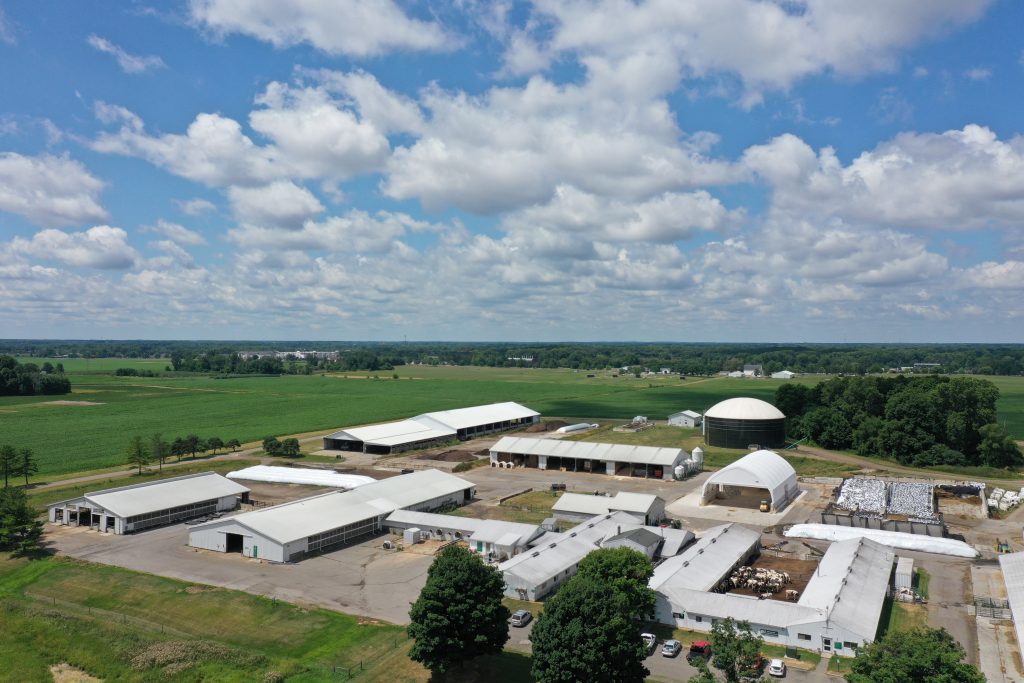In a state where dairy ranks No. 1 in farm receipts among state agricultural commodities, accounts for nearly 5 percent of the state’s gross domestic product, supports 111,000-plus jobs and generates $24 billion in revenue annually, it makes sense that Michigan’s land-grant university would have state-of-the-art dairy research and teaching facilities. That was the consensus of Michigan State University and more than 40 commodity groups when they rallied to raise $30 million to date for a new dairy facility – toward the goal of raising an additional $15-20 million.
When a fire broke out in the feed facility on MSU’s dairy in May 2021, the need for a new facility was accelerated, not to mention the 60-year-old setup fails to support the long list of desired research projects, veterinary school needs and basic education of current dairy trends and technologies. A big team of supporters began to brainstorm and put feet to the project.
“Leadership at Michigan State organized a planning committee with faculty from several departments in early 2021. Our aim was to determine what research, teaching and outreach infrastructure needs our program would have over the next 20 years,” explained Dr. Barry Bradford, MSU professor in dairy management and nutrition. “The work of this committee was accelerated in May 2021, when a major fire at the dairy facility made it clear that we couldn’t continue to play the long game.”
Bradford explained from there, the stakeholders were essential. “We had conversations with many agricultural groups, as well as environmental groups, to explain the need for a new dairy facility and the problems we could address with an investment by the state. Our friends in agriculture came through in a big way, advocating with elected officials about the importance of the dairy for Michigan agriculture and rural economies. Achieving state funding in July 2022 was a result of all of those conversations, and we are extremely grateful to our stakeholders and legislators who saw the value proposition.”
He singled out Michigan Milk Producers Association (MMPA) and its staff as an extremely important cog in the wheel of progress on funding. “MMPA was one of our strongest allies, with Doug Chapin and Sheila Burkhardt spending a lot of time helping with meetings and getting feedback on the project.”
Interim Michigan State University President Teresa K. Woodruff pointed to the importance of the ag community in securing the funding, “Michigan’s agricultural community is unique in its willingness to advocate for common goals with one voice, and we saw that sense of shared purpose play out with the dairy facility funding. Every phone call, every email, and every endorsement truly mattered in securing this transformational investment, and Michigan State University is so grateful for the support of our partners. This new facility will have a tremendous impact on Michigan agriculture – and we are proud that it is happening on our MSU campus.”
MSU AgBioResearch Director George Smith agreed it was a collaborative effort in the true sense of the word, involving the College of Agriculture and Natural Resource’s Department of Animal Science and Department of Biosystems and Agricultural Engineering, the Department of Large Animal Clinical Sciences in the College of Veterinary Medicine (CVM) , MSU AgBioResearch, Extension, the state’s dairy industry, the entire Michigan agricultural community and state government. Smith added that Bradford, Dr. Annette O’Connor and Dr. Wei Liao were the faculty leads and played an indispensable role in developing the vision and justification for the new facility.
“The vision for this project epitomizes the land-grant mission of Michigan State University and our goal to provide teaching, research and Extension efforts that make a difference for the Michigan dairy industry now and into the future,” Smith noted. “Our hope would be this project would help lead to growth in and a better trained dairy workforce in the future, increased rate of research progress in addressing issues of importance to the dairy industry (e.g. nutrition, genetics, reproduction, animal health and welfare and management) and in solving problems of the future related to environmental sustainability.”
The current trend of undergraduate students from non-farm backgrounds underscores the need for state-of-the-art facilities. He said, “A quality educational experience at a dairy facility that more closely mimics the modern dairy industry versus the industry of the 1960s and 1970s will provide a more positive experience. Increased herd size linked to the new facility and accompanying infrastructure will increase throughput on research linked to industry needs and provide further opportunities for long-term research linked to environmental sustainability, such as anaerobic digestion and nutrient recovery.”
“This investment in the state is also essential to helping CVM fulfill their mission to train the veterinary medicine workforce (DVM and veterinary nurses), who are able to meet the needs of the modern dairy industry “ said Dr. Annette O’Connor, Chairperson of the Department of Large Animal Clinical Sciences. “This facility will be one where students will have full access to the physical spaces, technologies, and access to data associated with the modern dairy industry. In addition to workforce development, our research teams will have access to facilities to answer questions about maintaining the health, welfare, and production of dairy cattle as part of sustainable dairy production.”
The present farm provides access to 200 cows in a tie-stall barn for teaching and research, and that’s not adequate for the research projects on the docket. While all the specifics have not been pinpointed, the new facility will be built directly south of the present dairy and will likely accommodate 500 milking cows, with 700 head total. This will allow researchers to perform their projects and still facilitate educational opportunities for vet students and animal science majors.

Both a robotic milking system and a parallel parlor are being planned for the new project. The robots would provide training and research on new milking systems, while the parallel parlor would be beneficial for research that includes milking at fixed intervals.
Additionally, Bradford said, “We have a great deal of mastitis expertise here, and it makes sense to keep the parlor simple and have the cows more accessible and available for individual quarter sampling or infusions.” He pointed to environmental challenges in dairy and the need for cutting-edge research to provide solutions for nutrient management and emissions reduction.
Having a new facility with modern housing will also bolster valuable information for Michigan dairy producers. “The new facility will allow us to actually do controlled nutrition research in free-housed cows by using technology that detects what cow is there and basically open access to feed if it’s the right cow, and that will provide meaningful data for the industry,” Bradford explained.
Improving the economics for dairy producers in Michigan is of vital importance to MSU, and he noted this improvement in the three pillars of sustainability: economic, environmental and social. “A lot of the work we’ve done for many decades has helped producers with economic sustainability, like making the best decisions with reproduction and nutritional programs. But we haven’t been able to help as much with environmental decisions like capturing carbon and separating phosphorus and nitrogen from manure or other nutrient management decisions. And we would like to be able to chase some of these challenges in the new facility, particularly when we can do so in a way that generates new revenue streams for dairies.”
MSU has already been a leader in optimizing anaerobic digestion on dairy farms. The MSU Anaerobic Digestion Research and Education Center (ADREC) has been working on value-added utilization of dairy manure and other wastes streams to enable a carbon neutral and zero-discharging dairy industry. Dr. Wei Liao, the director of MSU ADREC, explained: “Numerous research studies have been done on manure utilization, particularly anaerobic digestion of manure for renewable electricity and natural gas production. However, the current economics do not make them viable for small and medium-sized dairies in the U.S. In addition, nutrient (phosphorus and nitrogen) management of dairies needs to be further advanced to realize environmental sustainability for dairies”. With the new facility, plans are in place to integrate anaerobic digestion with electric vehicle charging stations to enable profitable systems to be implemented on smaller farms. Furthermore, MSU will work on finding cost-effective solutions to make phosphorus and ammonia removal from manure commercially viable.
Bradford described the third pillar of social sustainability with the goal of hosting consumers to give them an honest picture of the dairy industry and allowing them to see things for themselves. “But just as important, we think we can attract more students into the industry with a modern facility that has some cool technology, and help pipeline some students in that maybe that’s their calling – but they wouldn’t even give it a shot if they didn’t have something to draw their attention to it.”
“I can’t begin to express how much this means to MSU and, even more importantly, how much the transformational research made possible by this infrastructure investment will benefit Michigan farmers, their futures and livelihoods.” Smith said. “It’s been a collaborative approach, and one that we could never have endeavored on our own. Much appreciation is extended to the Governor’s office, Michigan legislature, commodity and farm organizations and our agricultural partners for assisting and providing support for these much-needed new research facilities, upgrades and improvements.”
With $30 million from the state, MSU will move forward with raising the remaining funds to complete the project. “We are excited for the future and grateful for what we have so far. We will continue to look for ways to raise the rest of the funds and to move the project forward,” Bradford concluded.
This article was originally published in the January/February 2023 issue of the Milk Messenger. Subscribe »

